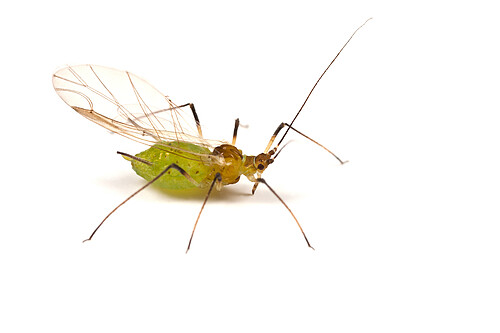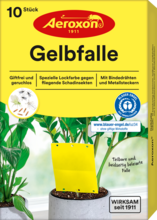
Aphids
Species
Species of the Aphidina family
Size
1 to 3 mm
Reproduction
A generation develops every 2 weeks in summer through the process of parthenogenesis (asexual reproduction)
Food
Plant juices
Damage
Drainage of plant juice through sucking causes plants to weaken and thereby causes flowers and fruit to die, vectors of disease transmission (carriers), visual degradation, contamination through sticky juices
Control measures
Adhesive traps for flying stages, insecticides, mechanical removal, home remedies
Detailed description
Aphids are described as a species of the family Aphidina, which are also part of the systematic group of plant suckers (Sternorrhyncha). Domestic aphids belong to the Aphididae whose adults have a genus-specific, tail-like protrusion (cauda) at the tip of the abdomen. Aphids have a distinct and commonly known body shape. Winged and non-winged forms co-exist. In general, aphids measure 1 to 3 mm in length. Their colour is specific to their species. They are frequently a yellow-green or brown colour.
Aphids are found on many crop plants. To some extent, certain host plants must be present in order for specific developmental phases to take place. The males and females of native species appear in autumn and only a few lay overwintering eggs. Only females hatch from these eggs, which even as larvae, give birth to several hundred fully developed insects (viviparia), which are also exclusively females that can reproduce asexually (parthenogenetically). These aphids usually have no wings (Virginoparae apterae), but can also be winged (Virginoparae alatae). A new generation develops every two weeks. Males and females (Sexuparae) only develop in autumn again. This generation change is usually associated with a change of host. Eggs are laid on certain perennial plants. The generations following thereafter generally only attack annual plants. The change of generation and host is referred to as a ‘holocycle’.
Aphids may look very anaesthetic due to their appearance in large numbers. Plants are damaged when aphids suck plant juice but are more likely to be damaged by the possible spread of plant diseases. Plants are covered in sugar-rich plant juice (honeydew) secreted by aphids. Micro-organisms then settle on this surface which can further damage the infested plant.
Insecticides are used to fight against aphids in professional crop farming. Adhesive traps can capture aphids during the winged phase. The adhesive traps are yellow in colour because the aphids are attracted to yellow.
Aphids can also be caught using small adhesive traps in potted household plants. It is important to set up the adhesive traps at an early stage because this application can only be used to combat aphids during the flying stages. In some cases, it’s also helpful to remove aphids by wiping off plants. A home remedy is to spray plants with nettle oil. The spray must be freshly made otherwise it won’t work.
Recommended Aeroxon products
Yellow Glue Trap for indoor and balcony plants
Non-toxic and ready-to-use glue trap for the control of harmful flying insects on indoor and balcony plants.


